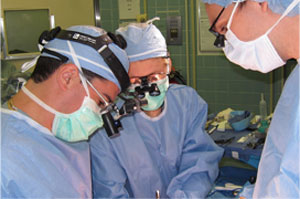Over the past several years, new medical therapies are available for patients with hemangiomas and vascular malformations.



Hemangiomas:
In 2007, Léauté-Labrèze1 and colleagues reported their serendipitous observation that beta-blockers were effective in halting the growth and stimulating the involution of proliferative hemangiomas of infancy. Since then, this beta-blocker therapy (administered orally* or topically**, depending on the type of hemangioma) has become the mainstay of medical treatment for hemangiomas, essentially supplanting corticosteroids, which had previously been used for over 40 years. With diligent monitoring and precautions, beta-blockers can be very effective and well-tolerated, with excellent results. Although certain types of hemangiomas require surgical intervention, the use of beta-blockers has diminished the role of surgery for hemangiomas.
* generic Propranolol or FDA-approved HemangeolTM
** Timolol
1Léauté-Labrèze, C et al. N Engl J Med. 2008 Jun 12;358(24):2649-51
Current research in hemangiomas & vascular malformations:
Over the past two decades, researchers over the world have made new discoveries regarding the etiology, genetics, and regulatory pathways involved in hemangiomas and vascular malformations. Collaborative study groups such as the Hemangioma Investigator Group have generated seminal articles describing important epidemiologic data and characteristics of hemangiomas – e.g. segmental anatomic distribution, patients at most risk of developing complications (e.g. ulceration), and other features. Studies are underway to discern if there is a genetic basis to PHACE Syndrome (Posterior Fossa or other CNS structural anomaly, Hemangioma, Arterial, Cardiac, and/or Eye Anomalies). A critical discovery by North and colleagues1, that hemangioma cells are GLUT-1 positive has become an important tool. GLUT-1 staining is currently utilized in many pathology laboratories to confirm the diagnosis of infantile hemangioma.
While two decades ago, there was a dearth of interest and research in the field of vascular anomalies, basic researchers have discovered numerous growth regulatory pathways in vascular anomalies, which ideally will lead to new targeted therapies. Vascular malformations syndromes have been identified (eg CLOVES, Proteus, PTEN Hamartoma Syndrome). Many genetic mutations have been identified (eg. RASA-1), also leading to an understanding of the pathways involved in the evolution of these disorders. Genetic testing is possible for many patients with vascular malformations – either from blood samples (for inherited vascular malformations) or from a biopsy of the affected tissue (for non-inherited types of vascular malformations).
Additionally, many registries have been formed, to collect patient information (and in some cases, blood samples) longitudinally, providing a data bank for studies. Specialty groups within professional organizations are mobilizing education programs to increase awareness in the medical community, and clinical trials to study different treatment regimens.
Recently, the classification of vascular anomalies was updated2 to incorporate many of these findings. Use of this classification is encouraged by all specialists involved with patients having hemangiomas and vascular malformations, in order to have all specialists utilize a common vernacular.
Sirolimus, a type of medication called an “m-Tor inhibitor” is being studied as a possible treatment for patients with a variety of vascular malformations and other vascular disorders (such as Kaposiform Hemangioendothelioma – KHE). In some studies this drug is being compared with standard therapies (e.g. Vincristine vs Sirolimus for KHE).
1Arch Dermatol. 2001 May;137(5):559-70
2Pediatrics. 2015 Jun 8. [Epub ahead of print]
